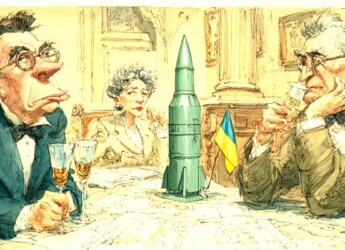|
|
Content Assessment: The Missiles of May? Russo-Ukrainian War Update (May 2-8, 2023)
Information - 95%
Insight - 93%
Relevance - 92%
Objectivity - 93%
Authority - 95%
94%
Excellent
A short percentage-based assessment of the qualitative benefit of the post highlighting the recent Ukraine conflict assessments in maps from the Institute for the Study of War.
Editor’s Note: The discipline of eDiscovery, which involves the identification, preservation, and analysis of electronic data, is increasingly being used in investigations and litigation relating to war crimes. In the case of the Russo-Ukrainian War, eDiscovery tools and techniques can be used to identify and collect electronic evidence of war crimes, such as emails, social media posts, and other digital communications that may provide valuable insights into the actions of individuals and organizations involved in the conflict. This evidence can then be used in investigations and legal proceedings to hold perpetrators of war crimes accountable for their actions. Additionally, eDiscovery can help to efficiently and effectively manage the vast amount of electronic evidence that may be relevant to war crimes cases, allowing investigators and legal teams to quickly and accurately analyze the data to identify key pieces of information. This weekly update may be useful for cybersecurity, information governance, and legal discovery professionals as they consider investigations and litigation resulting from war crimes committed during the war.*
Background Note: One of the most accurate and detailed sources for ongoing updates on the Ukraine crisis is the Russian Offensive Campaign Assessment from the Institute for the Study of War. The Institute for the Study of War (ISW) is a 501(c)(3) organization and produces strictly non-partisan, non-ideological, fact-based research. ISW seeks to promote an informed understanding of war and military affairs through comprehensive, independent, and accessible open-source research and analysis. ISW’s research is made available to the general public, military practitioners, policymakers, and media members. Providing a daily synthesis of key events related to the Russian aggression against Ukraine, ISW updates may benefit investigators and litigators as they follow the business, information technology, and legal trends and trajectories impacted by and stemming from the current Russo-Ukrainian conflict.
Assessment and Maps**
Russo-Ukrainian Conflict Assessments – An Overview in Maps
- Institute for the Study of War (ISW), Russia Team
- Critical Threats Project (CTP), American Enterprise Institute
General Assessment Background Info
- ISW systematically publishes Russian campaign assessments that include maps highlighting the assessed control of terrain in Ukraine and main Russian maneuver axes.
- These maps augment daily synthetic products that cover key events related to renewed Russian aggression against Ukraine.
The Russian Offensive Campaign Assessments
- May 8, 2023
- By Grace Mappes, Nicole Wolkov, Layne Philipson, Riley Bailey, Kateryna Stepanenko, Karolina Hird, and Frederick W. Kagan
Key Takeaways
- Russian forces conducted another large-scale missile and drone strike against Ukraine on the night of May 7 to 8.
- Senior Ukrainian officials indicated that Ukrainian forces may be preparing to conduct counteroffensive operations in May or June.
- Russian-occupied Transnistria called on Russia to increase its peacekeepers in the region likely to support the Kremlin’s efforts to destabilize Moldova.
- Russian President Vladimir Putin is attempting to use the Victory Day parade to show Russia’s continued influence in Central Asia.
- Russian forces conducted limited ground attacks on the Kupyansk-Svatove-Kreminna line.
- Russian forces have made marginal advances within Bakhmut as of May 8 amid reports of intensified Wagner Group forces offensive operations and continued ground attacks along the Avdiivka-Donetsk City line.
- Russian forces continued defensive operations in southern Ukraine.
- Russian authorities have reportedly escalated their campaign targeting ethnic minorities for contract service in the Russian military.
- Russian occupation authorities continued to forcibly evacuate civilians in rear areas in Kherson and Zaporizhia oblasts.
- May 7, 2023
- By Kateryna Stepanenko, Grace Mappes, Riley Bailey, Layne Philipson, and Frederick W. Kagan
Key Takeaways
- Wagner Group financier Yevgeny Prigozhin and Chechen leader Ramzan Kadyrov may have compelled the Russian theater commander in Ukraine, Army General Valery Gerasimov, to resume artillery ammunition distribution to Wagner forces in Bakhmut despite Gerasimov’s desired de-prioritization of that effort.
- Kadyrov’s threats to transfer his forces to Bakhmut may have blackmailed the Russian military command into allocating ammunition to Wagner mercenaries.
- Kadyrov likely supported Wagner’s blackmail efforts against the Russian military command to reestablish his position within the circle of power of the Kremlin.
- Gerasimov’s apparent need to negotiate with subordinate commanders and those commanders’ ability to force his hand suggests that chain of command problems are significantly impacting the Russian military’s ability to conduct coherent theater-wide operations.
- These events raise questions about Russia’s ability to coordinate a coherent theater-wide defensive campaign.
- Prigozhin’s and Kadyrov’s ability to significantly influence Russian military command decisions relies on Putin’s willingness to appease them and his reliance on their forces – both of which will likely degrade after further blackmail efforts.
- Prigozhin’s continued fight to complete the capture of Bakhmut contradicts his consistent narrative that capturing Bakhmut lacks strategic value.
- Russian forces continued limited offensive operations northeast of Kupyansk and south of Kreminna.
- Russian forces made some territorial gains in Bakhmut as of May 7 and continued limited offensive operations on the Avdiivka-Donetsk front.
- Russian sources claimed that Ukrainian forces launched up to 23 drones at Crimea on the night of May 6 to 7.
- Russian federal subjects are continuing to recruit and form regional armed formations and volunteer battalions.
- Russian occupation authorities continue to plan and carry out forced evacuations from Zaporizhia Oblast.
- May 6, 2023
- By Karolina Hird, Riley Bailey, Grace Mappes, and Mason Clark
Key Takeaways
- Wagner Group financier Yevgeny Prigozhin and Chechen Republic Head Ramzan Kadyrov stated their intent on May 6 for Chechen “Akhmat” troops to replace Wagner Group forces in Bakhmut on May 10.
- Prigozhin and Kadyrov likely aim to frame the Russian MoD and regular Russian troops as ineffective and set conditions to blame the MoD for any Russian setbacks in the Bakhmut area.
- While the potential deployment of Akhmat troops to Bakhmut could increase Russian combat power to some degree, the claims made by Prigozhin and Kadyrov are greatly exaggerated.
- The Russian MoD has yet to respond to Prigozhin and Kadyrov’s coordinated posturing about Bakhmut and may have been caught flatfooted by Prigozhin and Kadyrov’s statements.
- At least one individual with claimed but unconfirmed affiliation to the Ukrainian government attempted to assassinate Russian “A Just Russia” State Duma party co-leader and prominent nationalist voice Zakhar Prilepin on May 6.
- CNN reported that Russian electronic warfare (EW) jamming has limited the effectiveness of Ukrainian HIMARS strikes in recent months.
- Russian forces continued limited offensive operations northeast of Kupyansk and in the Kreminna area.
- Russian forces continued to make marginal gains within Bakhmut and Ukrainian forces likely conducted a successful limited counterattack southwest of Avdiivka.
- Russian occupation officials claimed that Ukrainian forces targeted Crimea with Hrim-2 short-range ballistic missiles.
- Ukrainian sources reported that Russian authorities are continuing various measures to forcibly mobilize residents of occupied areas of Ukraine.
- Russian occupation officials continue to plan for mass forced evacuations in Zaporizhia Oblast.
- May 5, 2023
- By Karolina Hird, Riley Bailey, Nicole Wolkov, Grace Mappes, Layne Philipson, and Frederick W. Kagan
Key Takeaways
- The Russian Ministry of Defense (MoD) appears to have deprioritized the Bakhmut offensive in favor of preparing to defend against an anticipated Ukrainian counteroffensive, putting the Wagner Group and Wagner financier Yevgeny Prigozhin in a potentially difficult position.
- Wagner’s continued persistence within Bakhmut is incongruent with the overall slow-down in the pace of Russian operations elsewhere in Ukraine as conventional Russian forces appear to largely be shifting focus to prepare to receive the much-anticipated Ukrainian counteroffensive.
- Recently dismissed former Deputy Minister of Defense for Logistics Colonel General Mikhail Mizintsev is reportedly serving as deputy commander of the Wagner Group, likely as part of Wagner’s campaign to retain access to Russian military supplies.
- Russian Defense Minister Sergei Shoigu ordered newly-appointed Deputy Minister for Logistics Alexei Kuzmenkov to control the supply of weapons and equipment to Russian forces in Ukraine.
- Russian occupation authorities announced the forced removal of 70,000 civilians in occupied Zaporizhia Oblast to areas deeper in the Russian-occupied rear under the guise of evacuations.
- The Russian Ministry of Internal Affairs (MVD) proposed a draft bill aimed at appealing to growing anti-migrant sentiments in Russia and supporting the Russian military’s efforts to recruit migrants.
- Russian Human Rights Council head Valery Fadeev reportedly stated that Russian authorities should regulate Telegram channels similarly to how Russia censors state-controlled media.
- Russian forces conducted ground attacks near Kreminna and Avdiivka and made marginal gains within Bakhmut.
- Russian milbloggers claimed that Ukrainian forces conducted limited counterattacks near Bakhmut.
- The Russian Federal Security Service (FSB) claimed it prevented a Ukrainian assassination attempt against an occupation deputy of the Zaporizhzhia Nuclear Power Plant (ZNPP) on May 5.
- Chechen Republic Head Ramzan Kadyrov continues his own personal force generation efforts aimed at securing Russian President Vladimir Putin’s favor.
- Russian occupation authorities continue measures to strengthen social control of occupied territories.
- May 4, 2023
- By Riley Bailey, Karolina Hird, Kateryna Stepanenko, Nicole Wolkov, Layne Philipson, and Frederick W. Kagan
Key Takeaways
- Russia conducted another Shahed-131/136 strike against Ukraine on May 4.
- Russian officials are likely using the May 3 drone strike on the Kremlin to expand cancellations of parades for the May 9 Victory Day holiday.
- The Kremlin is reportedly continuing its overhaul of domestic security organs.
- US Director of National Intelligence Avril Haines stated that Russian forces are likely unable to conduct a “significant offensive” in 2023 due to munitions and manpower shortages regardless of the success of the Ukrainian counteroffensive.
- Russia and India reportedly suspended efforts to trade in rupees.
- Russian sources claimed that Russian forces made territorial gains south of Kreminna.
- Ukrainian forces likely conducted a limited counterattack southwest of Bakhmut.
- Russian forces continued ground attacks in and around Bakhmut and along the Avdiivka–Donetsk City line.
- Russian sources claimed that Russian forces repelled Ukrainian forces in Zaporizhia Oblast.
- The Kremlin is attempting to increase the production quotas of military supplies despite reportedly lacking the necessary manpower.
- Russian occupation authorities continue to announce new security measures in an effort to prevent partisan attacks in occupied territories.
- May 3, 2023
- By Karolina Hird, Grace Mappes, Nicole Wolkov, Layne Philipson, and Frederick W. Kagan
Key Takeaways
- Russia accused Ukraine of conducting a drone strike against the Kremlin.
- Russia likely staged this attack in an attempt to bring the war home to a Russian domestic audience and set conditions for a wider societal mobilization.
- The rapid and coherent presentation of an official Russian narrative around the strike suggests that Russia staged this attack in close proximity to the May 9th Victory Day holiday in order to frame the war as existential to its domestic audience.
- Some Russian nationalist milbloggers seized on the Kremlin drone strike to call for Russian escalation in the war despite the fact that Russia currently lacks the military capability to do so.
- The Kremlin may be planning to conduct other false flag operations and to increase disinformation ahead of a Ukrainian counteroffensive in order to increase domestic support for the war.
- Wagner Group financier Yevgeny Prigozhin baselessly claimed on May 3 that the Ukrainian counteroffensive has already begun, likely in order to exploit information space anxieties and call for increased Russian military support for Wagner’s Bakhmut offensive.
- Russian forces conducted a Shahed-131/136 drone strike on the night of May 2 to 3.
- Russian forces continued limited ground attacks near Kreminna.
- Russian forces continued to make gains in and around Bakhmut and continued to conduct ground attacks on the Avdiivka-Donetsk City line.
- Russian forces conducted heavy air and artillery strikes against west (right) bank Kherson Oblast.
- Russian officials continue to incentivize military service by providing social benefits to families of participants in the war.
- The Russian Federal Security Service (FSB) claimed that it prevented a “terrorist” attack against three Crimean officials.
- May 2, 2023
- By Riley Bailey, Grace Mappes, Kateryna Stepanenko, and Mason Clark
Key Takeaways
- Russian Defense Minister Sergei Shoigu claimed that the Russian defense industrial base (DIB) is increasing its production of precision missiles for use against Ukraine.
- Shoigu likely seeks to deflect intensifying accusations that the Russian Ministry of Defense (MoD) cannot provide sufficient ammunition to Russian forces.
- Russian reactions to a claimed strike against Ukrainian Territorial Defense Forces Commander Major General Ihor Tantsyura suggest Russian ultranationalists are attempting to frame any Russian operations as delaying potential Ukrainian counteroffensive actions.
- The Kremlin reportedly distributed a new manual instructing Russian state media on how to cover an upcoming potential Ukrainian counteroffensive that, if real, indicates the Kremlin is setting informational conditions both for an effective Russian defense and to mitigate shocks in the Russian information space from Ukrainian successes.
- UN member states, including key Russian partners like China, India, and Brazil, voted to adopt a resolution on April 26 that acknowledges Russia as the aggressor of the war in Ukraine.
- Russian forces conducted limited ground attacks on the Kupyansk-Svatove-Kreminna line.
- Russian forces made marginal gains near Bakhmut but did not advance within the city itself.
- Russian forces continued limited offensive operations along the Avdiivka-Donetsk front, and Russian sources claimed that Ukrainian forces conducted limited and local counterattacks in the Avdiivka area.
- Ukrainian forces continue to operate on and around islands in the Dnipro River delta in Kherson Oblast.
- Russian government officials are continuing to introduce new social benefits to veterans and their families to incentivize further military recruitment efforts in Russia.
- Likely Ukrainian partisans targeted an unspecified Zaporizhia Oblast occupation Ministry of Internal Affairs deputy head in Melitopol.
We do not report in detail on Russian war crimes because those activities are well-covered in Western media and do not directly affect the military operations we are assessing and forecasting. We will continue to evaluate and report on the effects of these criminal activities on the Ukrainian military and population and specifically on combat in Ukrainian urban areas. We utterly condemn these Russian violations of the laws of armed conflict, Geneva Conventions, and humanity even though we do not describe them in these reports.
Chronology of Maps from May 2 – 8, 2023 – Mouseover to Scroll
Ukraine Conflict Maps – 050223 – 050823See the Institute for the Study of War Interactive Map of the Russian Invasion
Read the latest Ukraine Conflict updates from the Institute for the Study of War
* Shared with direct express permission from the Institute for the Study of War (ISW).
About the Institute for the Study of War Research Methodology
ISW’s research methodology relies on both primary and secondary sources, enabling researchers to develop a comprehensive understanding of the situation on the ground. In order to analyze military and political developments in any given area, ISW’s research analysts must wholly understand the systems of enemy and friendly forces. They must also understand the population demographics, physical terrain, politics, and history of that area. This lays the analytical foundation for understanding the reasons for particular developments and fulfilling their assigned research objectives. ISW analysts also spend time in places like Iraq, Afghanistan, and elsewhere in order to gain a better understanding of the security and political situation and to evaluate the implementation of current strategies and policies. Our researchers compile data and analyze trends, producing a granular analysis of developments in areas of research, producing an accurate, high-resolution, timely, and thorough picture of the situation. ISW’s research methodology guarantees its success and commitment to improving the nation’s ability to execute military operations, achieve strategic objectives, and respond to emerging problems that may require the use of American military power.
About the Institute for the Study of War
The Institute for the Study of War advances an informed understanding of military affairs through reliable research, trusted analysis, and innovative education. We are committed to improving the nation’s ability to execute military operations and respond to emerging threats in order to achieve U.S. strategic objectives. ISW is a non-partisan, non-profit, public policy research organization.
Learn more, get involved, and contribute today.
Additional Reading
- From Dissent to OSINT? Understanding, Influencing, and Protecting Roles, Reputation, and Revenue
- [Annual Update] International Cyber Law in Practice: Interactive Toolkit
- Data Embassies: Sovereignty, Security, and Continuity for Nation-States
**Assisted by GAI and LLM Technologies
Source: ComplexDiscovery


























